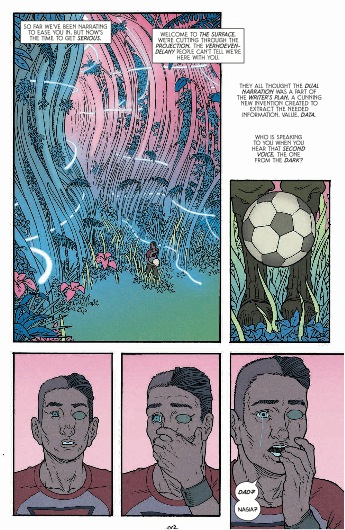Writer – Ales Kot
Artist – Langdon Foss
Colourist – Jordie Bellaire
Letterer – Clayton Cowles
Publisher – Image Comics
There is this creeping feeling expressed as you make your way through The Surface #2, as if the creative team has somehow found a way to experience the surreal minus the substance abuse. The Surface began and is firmly making its imprint as a modern day simulacrum of a cautionary tale, while also being aware of how satirical and meta it is being. There are moments of absurdist humour as well, such as the rubik’s cube hanging from a tree and the group of bugs engaging in coitus while one of them stands up holding a boom box that can only aptly be named John Beesack.
One of the great stand out moments from this issue occurs when a soccer ball appears out of nowhere, knocking into one of the main characters, Mark. As the item makes contact with him, he drifts away from his group of friends. As he makes his way through a gorgeously coloured – thanks to Jordie Bellaire – stream of vegetation, Mark all of a sudden encounters a memory of his childhood. He recollects, or quite possibly is seeing in real time, himself as a kid playing soccer with his dad. The memory ends with young Mark embracing his Dad, passing on a piece of fatherly wisdom that still resonates with Mark quite profoundly, judging from his emphatically drawn, tear filled face. The green tentacles of vegetation have created this organic freezing of time right in front of Mark, forming a statue of young Mark hugging his Dad. Mark looks over at Nasia, saying in disbelief: “…this place is real.”
This powerful moment acts a reminder that this connection we still share with a physical reality is to be understood through memories and dreams; although surreal as they can be. The Surface, however, is teetering towards the detachment from this physical reality, as exhibited in the alternate experience Nasia has with the apes. Nasia begins to realize that the narration is no longer, perhaps never was, a detached voice, but a real, omniscient force. The dual narrations appear as two realities fighting to not only accept one another, but make sense out of all the sensory overload and surrounding barrage of dense imagery. Ales Kot is playful interacting with the very characters he is writing, blurring the line of fiction.
 Langdon Foss and Jordie Bellaire are and hopefully will be a team seen on more books in the near and very far future. Foss’s images appear organic, considering the overall theme of this disconnected book. Bellaire enhances the environments and characters further that you can almost feel the brushing of the blue stalk of grass along Nasia’s legs or the warming sensation of the pink lake the three friends find themselves in. Nasia initiates through a clever, slow colour change the shifting away from the comfortable blues, greens and pinks of this hyper-real landscape into the stark reality of orange, browns and greys. Considering her hair is pink, Nasia is sure to play a major role in challenging the attempts at altering the status quo threatened in the latter half of this issue.
Langdon Foss and Jordie Bellaire are and hopefully will be a team seen on more books in the near and very far future. Foss’s images appear organic, considering the overall theme of this disconnected book. Bellaire enhances the environments and characters further that you can almost feel the brushing of the blue stalk of grass along Nasia’s legs or the warming sensation of the pink lake the three friends find themselves in. Nasia initiates through a clever, slow colour change the shifting away from the comfortable blues, greens and pinks of this hyper-real landscape into the stark reality of orange, browns and greys. Considering her hair is pink, Nasia is sure to play a major role in challenging the attempts at altering the status quo threatened in the latter half of this issue.
The Surface #2 advances towards a further understanding of what exactly is meant by the title, questioning not only the characters as they struggle early on to dig deep within themselves but the readers as well. The grander question is asked outside the frames of the comic itself through a well placed quote from Stanislaw Lem’s Solaris in the back of the issue, stating: “We don’t need other worlds. We need mirrors.” Escaping into false or alternative realities/places only deviates this fear of pointing at the source of a lot of the problems and insecurities of this modern world we live in: us.


